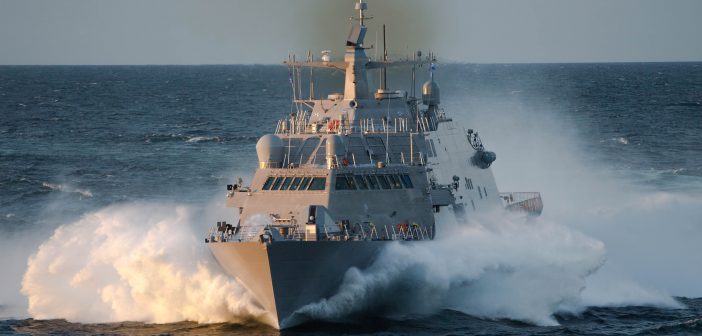The US needs to commit to building up seapower, but the Navy needs to do a better job with the resources it has
Chief of Naval Operations Admiral Mike Gilday, speaking at an online conference in early December, spoke about the need to convince the incoming Biden administration of the importance of the Navy.
“I think internally certainly we’ll have challenges again with the new administration in terms of explaining the rationale for making the investments in the naval force,” he told those logging on to the US Naval Institute’s Defense Forum.
Gilday, speaking of still-in-production littoral combat ships, also declared he’d “like to decomm[ission]the first four LCS test platforms. … I’m not a proponent of sinking a lot of money into those vessels that I could put in other places to buy me more lethality.”
But those first four ships are barely halfway through their planned 20-year lifespans. Freedom has been in service 12 years, Independence 10, Fort Worth eight, Coronado seven. Only three of the ships made the kind of forward-based deployment they were designed for, and only one deployment each. They are far from worn out, nor has the taxpayer or warfighter gotten the kind of return the Navy promised.
A total of 21 LCSs are in commission, with four more to enter service this year. Another ten are in various stages of construction. More new LCSs enter the fleet each year than any other type. Deliveries will continue at least through 2025 and a total of 35 will be built before production shifts to the new Constellation-class frigate. Well over $8 billion has been spent to buy the ships, several billion more allocated to various mission components, and even more money has been invested in specialized support systems and sophisticated training facilities.
Both LCS designs – the Freedom LCS 1 variant and the Independence LCS 2 – have been modified since those first four ships were delivered, and the Navy claims it’s not worth modifying the first four, saying they were meant as prototypes. That directly contradicts dozens of declarations throughout the early years of the program from top Navy officials claiming the ships were intended to be fully operational fleet units and not prototypes at all. That kind of shift in tone and purpose has been a hallmark of the program for much too long.
The issues and problems surrounding LCS would fill a dense book and then some. Nearly all the original goals for the ships have been superseded by revised concepts and objectives. Succeeding uniformed and civilian leaders have altered many of the program’s fundamental precepts far beyond those first intentions. Those who initiated the program would scarcely recognize it today, and serious studies continue over how to use the warships.
LCS critics are always eager to pounce on the program. The Navy is notoriously gun-shy of just about any LCS story -– good and bad — because of never-ending controversies and a variety of interpretations. A host of oversight entities, including Congressional committees, the Government Accountability Office, the Pentagon’s Office of Test and Evaluation and more, routinely decry long-standing program errors despite the oft-unspoken open secret that all those groups have been involved from the beginning. Critics focus on failings of a component or system or concept. Government-imposed delays abound in the name of making things perfect before they can be used.
And yet the program is having some successes. Leading the way is USS Gabrielle Giffords, who left San Diego in September 2019 and carried out a successful western Pacific cruise operating from Singapore in a deployment very close to the original LCS concept. She transitioned in mid-2020 to US Southern Command and continues to carry out counter-drug and illegal immigration missions around Central America. The Giffords was joined in those missions during the latter months of 2020 by two Mayport-based LCSs, Detroit and Sioux City – the first time three LCSs were simultaneously deployed. And arming the Giffords and Montgomery with over-the-horizon cruise missiles on their recent Pacific deployments caused noticeable concern among the Chinese.
Several Navy and Navy-led efforts are coming to fruition, including decisions on how to operate the ships and where. Nearing completion is an investigation into the combining gear problem that has plagued the Freedom class for years and reduced their reliability. Lockheed Martin and its subcontractor Renk AG are said to be nearing definitive solutions to this nagging issue that needs to be fixed. They should, it’s their responsibility. But 2021 promises to be the most active LCS year yet.
Hope so. But these promises have been coming from Navy leaders since the program’s inception. In the history of the US Navy there has never been anything like LCS, not just in concept and problems but the incredible duration of those problems. LCSs weren’t bought to operate in SOUTHCOM. They already should be operating in the Persian Gulf, the Horn of Africa, the South China Sea, the Mediterranean and the Baltic. They should not be crowding pier space at San Diego and Mayport or cruising the Caribbean.
In the big picture, the ongoing problems with LCS and the seemingly never-ending course corrections to address those problems are a failure of executive Navy management. A succession of leaders has either left problems to those who came after them or decided that those who came before were all wrong and needed to be corrected. Individually those efforts may have been well-intentioned but the result is a long history of inconsistency. The overall result is that at the beginning of 2021 only one LCS is deployed and we have a CNO calling for the first four to be thrown away – a call partially rebuked by Congress when they denied funds to decommission Fort Worth and Coronado.
The Navy is at the forefront in meeting the fast-growing challenges from China and Russia. But big navies are expensive to buy and maintain and take a long time to develop. We don’t yet know how the Bidens view the Navy and where they want the military’s emphasis, but to justify itself the sea service is going to have to do a lot better in deploying the LCS and building the new frigate. The aircraft carrier program’s long-troubled USS Gerald R. Ford seems to have turned the corner over the past year and a new positive atmosphere and spirit pervades that effort. The same needs to happen elsewhere to convince the country’s leadership that maritime investment is worth the expense.
Step one is that from now on, fix it and stop changing LCS. No more excuses. Just make it work.
Published 10 Jan 21 7pm




